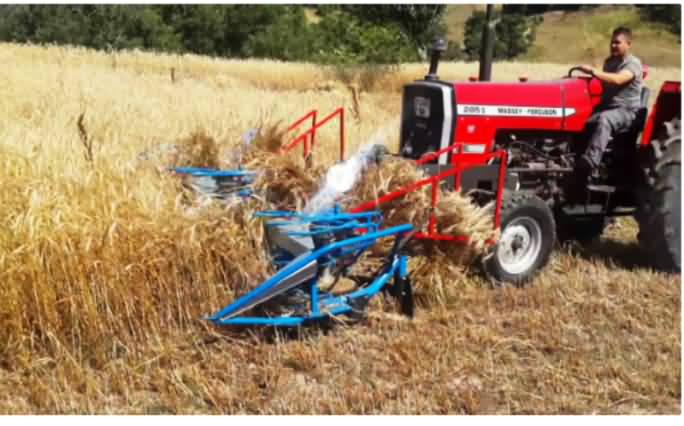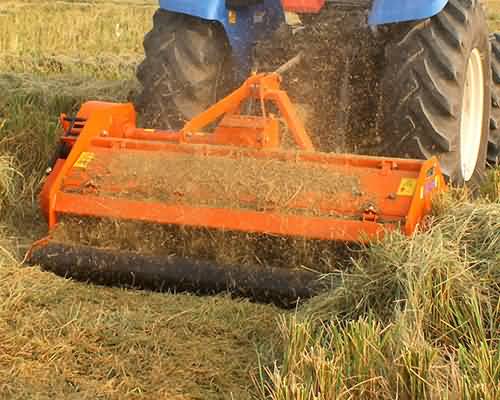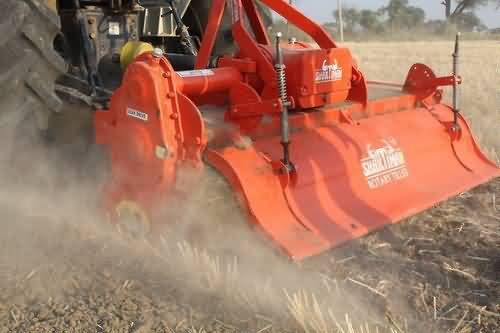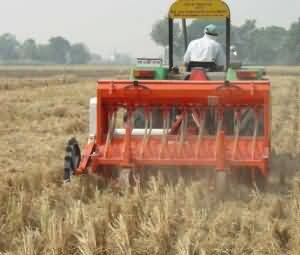फसल अवशेष प्रबंधन: रणनीतियाँ और चुनौतियाँ
Food grain production after first green revolution has increased from 50.82 to 285.21 million metric ton to feed growing population. India during 2020-21 has expected to produce about 122.27 million tons (Mt) of rice, 109.52 Mt of wheat, 51.15 Mt of coarse cereals, 25.72 Mt of pulses and 36.10 Mt of oil seeds (The Economic Times, 2021).
With the increase in grain production straw production has also increased proportionally. Current production of crop residues in India is 501.73 million tones. Highest quantities of crop residue are generated in Uttar Pradesh greater than 60 Mt, followed by Punjab and Maharashtra.
Among different crops, cereals generate maximum residues (352 Mt), followed by fibers (66 Mt), oilseeds (29 Mt), pulses (13 Mt) and sugarcane (12 Mt). Cereal crops (rice, wheat, maize, millets) contribute 70%, while rice crop alone contributes 34% to the crop residues. Sugarcane residues consisting of top and leaves generate 12 Mt, i.e., 2% of the crop residues in India.
Cellulose, hemicelluloses and lignin are dominant components in the crop residues besides pectin, protein extractives, sugars, and nitrogenous material, chlorophyll and inorganic waste also present in smaller quantities (Chandra et al., 2012). Carbon to nitrogen ratio of crop residue influences the decomposition rate and immobilization of native nitrogen.
Average C: N of cereals is 60-80:1. For the release of nutrients especially nitrogen in crop residues C: N ratio should be lowered to <20:1. The process is mediated by micro organisms which can act on primary and secondary products plants, and decompose.
Reason for crop residue burning
- In the old time Indian farmers used to maintain cattle in his shed, crop residues especially paddy, maize and jowar residue were used as cattle feed. With time farmers neglected animal husbandry due to shortage of labour and mechanization.
- Time gap between kharif and rabi seasons are little to allow the residues decompose in the field in-situ.
- Sowing of subsequent crop with small sized seed will be difficult
- Yellowing of subsequent crop if incorporation of crop residue was done.
- To suppress soil born pest and diseases residue burning was adopted
- Lack of awareness on soil health, quality, nutritional benefits of incorporation and environmental hazard.
- Farm machinery to recycle in-site manage crop residues are lacking
- Inadequate policy support / incentives for crop residue recycling
Problems of residue burning
Soil is the bin of nutrients which supports crop growth. Nutrients taken from the soil must be return back to the soil. Burning of crop residues leads to the following
Loss of nutrients:
Burning of one tonne of rice straw accounts for loss of 5.5 kg nitrogen, 2.3 kg phosphorus, 25 kg potassium and 1.2 kg sulphur (NPMCR, 2014). Burning of one tone of cotton stalks accounts for loss of 6.2 kg Nitrogen, 0.8 kg phosphorus, 6.1 kg potassium and 1.5 kg sulphur besides, organic carbon (Ramanjanelu et al., 2021).
Impact on soil properties:
Crop residue burning could degrade soil physical, chemical and biological properties. Heat from burning residues elevates soil temperature causing death of beneficial soil organisms. Microbial biomass carbon and nitrogen were declined by 27.2 and 40.9 %, respectively under rice straw burning over incorporation (Naresh, 2013).
Soil nutrient status especially available N was effected more as compared to other nutrients. Available N content could decline by 207 % within three years. Phosphorus and potassium observed decline under burning plot by 44.8 and 25.4 %, respectively, compared to straw incorporation. Under long run (3 years) straw burning could decline aggregate stability (> 250 μm) of soil by 26.4%.
Emission of greenhouse and other gases:
Burning of crop residues emits Green House Gases (GHGs), other aerosols and hydrocarbons which contributes to global warming. It is estimated that upon burning one tone of paddy straw could release 60 kg carbon monoxide, 1460 kg carbon dioxide, 2 kg sulphur oxides and 3kg particulate matter (Bimbraw, 2019), which health hazards, loss of biodiversity of agricultural lands, and the deterioration of soil fertility.
Nutrient potential of crop residues
Applied nutrients/ fertilizers to the soil are absorbed into the plant body and assimilated in to tissue. Some nutrients will translocate into grains the remaining are present in the other plant parts like stubbles, straw, roots. Hence crop residues are potential source of nutrients (Table 1), if we incorporate / decompose them in soil. It is estimated that an average 30–35% of applied N and P and 70– 80% of K accumulate in the crop residues of food crops.
About 40% of N, 30–35% of P, 80–85% of K, and 40– 50% of the S uptake by rice remains in the vegetative parts at maturity (Dobermann et al., 2002). Similarly, about 25–30% of N and P, 35–40% of S, and 70–75% of K uptake is retained in wheat residue (Singh and Sindhu., 2014). Conversely, crop residues contains around 40% carbon (on dry weight basis) which could improve organic matter content in soil if residues are incorporated.
Carbon-enriched crop residue is the food source for soil microorganisms and fauna, and as a result ‘nurtures’ the nutrient cycling. Soil organic matter is indispensable for improving soil condition congenial for plant growth, helps in attaining sustainability in crop yields.
Table 1: Nutrient concentration of different crop residues
|
Crop |
N (%) |
P2O5 (%) |
K2O (%) |
Total nutrient |
Kg nutrient per ton residue |
|
Rice |
0.61 |
0.18 |
1.38 |
2.17 |
21.7 |
|
Sorghum |
0.52 |
0.23 |
1.34 |
2.09 |
20.9 |
|
Maize |
0.52 |
0.18 |
1.35 |
2.05 |
20.5 |
|
Pulses |
1.29 |
0.36 |
1.64 |
3.29 |
32.9 |
|
Oil seed |
0.80 |
0.21 |
0.93 |
1.94 |
19.4 |
|
Ground nut |
1.60 |
0.23 |
1.37 |
3.20 |
32.0 |
|
Sugarcane |
0.40 |
0.18 |
1.28 |
1.86 |
18.6 |
Bhattacharjya et al., 2019
Management-Strategies
Feed for livestock:
Paddy straw, maize, jowar stalks used as feed for cattle. Paddy straw may be poor source of proteins (Goswami et al., 2020). However farmers of India using the straw material as feed. Storing the straw as silage and hey besides adding required nutrients will prove nutrients to cattle and use residue effectively.
Surface retention as mulch:
Using crop residue as soil mulch is a recommended practice for raifed and irrigated dry crops. Mulching of crop residue requires transfer of straw/ biomass off the field before land preparation and sowing and then returned by making the stalks into appropriate size. Mulching will help to save water and increase nutrient use efficiency.
Packaging for transport
Paddy straw is also widely used as a low-cost packaging material particularly for fruits and furniture’s packing in metropolitans of India.
Composting:
Composting is the natural process of decomposition of organic material by micro-organisms under controlled conditions. There are many microbial consortiums (PJTSAU consortium, pusa decomposer and waste decomposer) are available in the market. These microbes will hasten the process of decomposition and converts organic material or crop residue to compost.
Compost preparation can be aerobic or anaerobic method depending on the nature of bacteria, fungi or algae involved in the degradation. Conversely, farmers can use cow dung as source of microbes which can fasten decomposition process. Half decomposed crop residues can be used as raw material to produce vermicompost. It is the product of the decomposition process using earthworms.
One-inch thick bio compost layer could add approximately 1.0 ton/ha of total Nitrogen, 13.3 ton/ha of carbon, 24 t/ha of organic carbon and 1.02 t/ha of organic nitrogen in the soil besides imparting nutrients such as P, K, Ca, Mg, S, Iron, Zn, etc (Pratap Singh and Prabha, 2017)
Biochar
Biochar is the product of pyrolysis of biomass waste, is highly porous, fine-grained, carbon dominant product rich in paramagnetic centers having both organic and inorganic nature, with large surface area possessing oxygen functional groups and aromatic surfaces (Atkinson et al., 2010).
Application of biochar prepared from crop residues could improve soil physical chemical and biological properties of soil. Biochar prepared from rice husk and cotton seeds and shell decreased soil bulk density, increased exchangeable K and water holding capacity at 90 t ha-1 in calcarious soils (Liang et al. 2014).
In silty loam soils biochar reduced soil bulk density by 13% and increased soil-C by 7% (Mukherjee et al. 2014). In sandy loam soils maize biochar enhanced the soil available N and P; Wheat biochar increased the soil available K; Rice biochar being relatively labile in soil fuelled the proliferation of microbial biomass (Purakayastha et al. 2015)
In-situ management with mechanization
With advancement of technology in agriculture there developed innovative machinery which is useful to manage crop residue. The following are the few of its kind
- Reaper Binder: It can be used to harvest paddy, sesame and other smooth stem crops, bind the stem and make bundles (Fig. 1a)
- Baler: After harvesting of paddy with harvester, baler used for collection of the left over straw and makes bales. Transportation and storing of paddy straw will be easier with bales (Fig 1b)
- Straw Chopper: After harvesting of paddy or other succulent stem crops, straw chopper will be useful for cutting the straw/ stalks in to small pieces for easily mixing with the soil (Fig 1c)
- Rotary mulcher: After harvesting of paddy or other succulent stem crops, rotary mulcher cut the straw/ stalks in to small pieces and spreads on soil as mulch (Fig 1d)
- Rotavator: it can be useful for preparation of land by cutting and incorporating crop stubbles in the soil (Fig 1e)
- Zero till seed drill: useful for sowing of the seeds in the previous crop stubbles with minimum disturbance to the soil (Fig 1f)
- Happy Seeder : used for sowing of crop in standing stubble (Fig 1g)
| Fig 1. Different machinery to manage crop residue in-situ in the field | |
 Fig 1a: Reaper Binder Fig 1a: Reaper Binder |
 Fig 1b: Baler Fig 1b: Baler |
|
|
|
|
|
|
|
Fig 1g: Happy seeder |
|
Challenges in residue management
- Paddy straw contains high amount of silica (8-14%) which is indigestible and decreases digestibility of the feed hence supports poor nutrition to cattle, besides low protein content (2-7% crude protein).
- Crop residue decomposition especially cereal, fiber crops. Decomposition is the product of quality (C:N and composition) of residue, microbial population and soil environment.
- Availability of machinery to incorporate the straw in soil
- Limited government policies which support the crop residue management.
- Mulching of residues requires more labour
- N immobilization occurs after incorporation of crop residue which hampers initial plant growth (as the time gap between two crops is low).
Conclusion
With machine harvesting in crops, residue generated in the field was burnt in order to maintain the field clean. However, there are multiple options to manage crop residue in and off the field. There are few machinery which helps on better management of crop residue such as straw chopper, rotavator and happy seeder. Incorporation of residues directly or by making secondary products (such as compost, biochar etc.,) soil physical, chemical and biological properties gets improved; besides air pollution can be curbed.
Bibliography:
- Atkinson CJ, Fitzgerald JD and Hipps NA. 2010. Potential mechanisms for achieving agricultural benefits from biochar application to temperate soils: A review. Plant and Soil 337(1): pp 1-18
- Bhattacharjya, S., Sahu, A., Manna, M.C. and Patra, A. K. 2019. Potential of surplus crop residues, horticultural waste and animal excreta as a nutrient source in the central and western regions of India. Current Science 116 (8), 1314-1323
- Bimbraw, A.S. 2019. Generation and Impact of Crop Residue and its Management. Current Agriculture Research Journal (3) 2019, pg. 304-309
- Chandra, R.; Takeuchi, H.; Hasegawa, T. 2012. Methane production from lignocellulosic agricultural crop wastes: A review in context to second generation of biofuel production. Renewable and Sustainable Energy Reviews 16, 1462–1476
- Dobermann, A., and Fairhurst, T. H. 2002. Rice straw management. Better Crops International, Special supplement publication: Rice Production pp: 16.
- Goswami, S.B., Mondal, R., and Mandi, S.K. 2020. Crop residue management options in rice–rice system: a review, Archives of Agronomy and Soil Science 66:9, 1218-1234,
- Liang F, Li GT, Lin Q and Zhao XR. 2014. Crop yield and soil properties in the first 3 years after biochar application to a calcareous soil. Journal of Integrative Agriculture 13(3): 525-532
- Mukherjee A, Lal R and Zimmerman AR. 2014. Effects of biochar and other amendments on the physical properties and greenhouse gas emissions of an artificially degraded soil. Science of the Total Environment 487: 26-36
- National Policy for Management of Crop Residues 2014, Government of India Ministry of Agriculture Department of Agriculture & Cooperation, Krishi Bhawan, New Delhi pp-2.
- Pratap Singh, D.; Prabha, R. 2017. Bioconversion of Agricultural Wastes into High Value Biocompost: A Route to Livelihood Generation for Farmers. Advances in Recycling and Waste Management 137
- Purakayastha TJ, Kumari S and Pathak H. 2015. Characterization, stability, and microbial effects of four biochars produced from crop residues. Geoderma 239-240, 293-303
- Ramanjaneyulu, A.V., Ramprasad, B., Sainath, N., Umarani, E., Pallavi, Ch, Vijay, J and Jagadeeshwar, R., 2021. Crop Residue Management in Cotton. Chronicle of Bioresource Management 5(1):001-008.
- Singh, Y.; Sidhu, H.S. 2014. Management of cereal crop residues for sustainable rice-wheat production system in the Indo-gangetic plains of India. Proceedings of Indian National Science Academy 80, 95–114.
Authors
A Krishna Chaitanya1*, P Ravi1, Ch Venu Reddy1, P Madhukar1 and M Uma Devi1
1Regional Agricultural Research Station, Polasa, Jagtial-505 529, PJTSAU
*E mail:

 Fig 1c: Straw Chopper
Fig 1c: Straw Chopper Fig 1d: Rotary Mulcher
Fig 1d: Rotary Mulcher Fig 1e: Rotavator
Fig 1e: Rotavator Fig 1f: Zero till seed drill
Fig 1f: Zero till seed drill